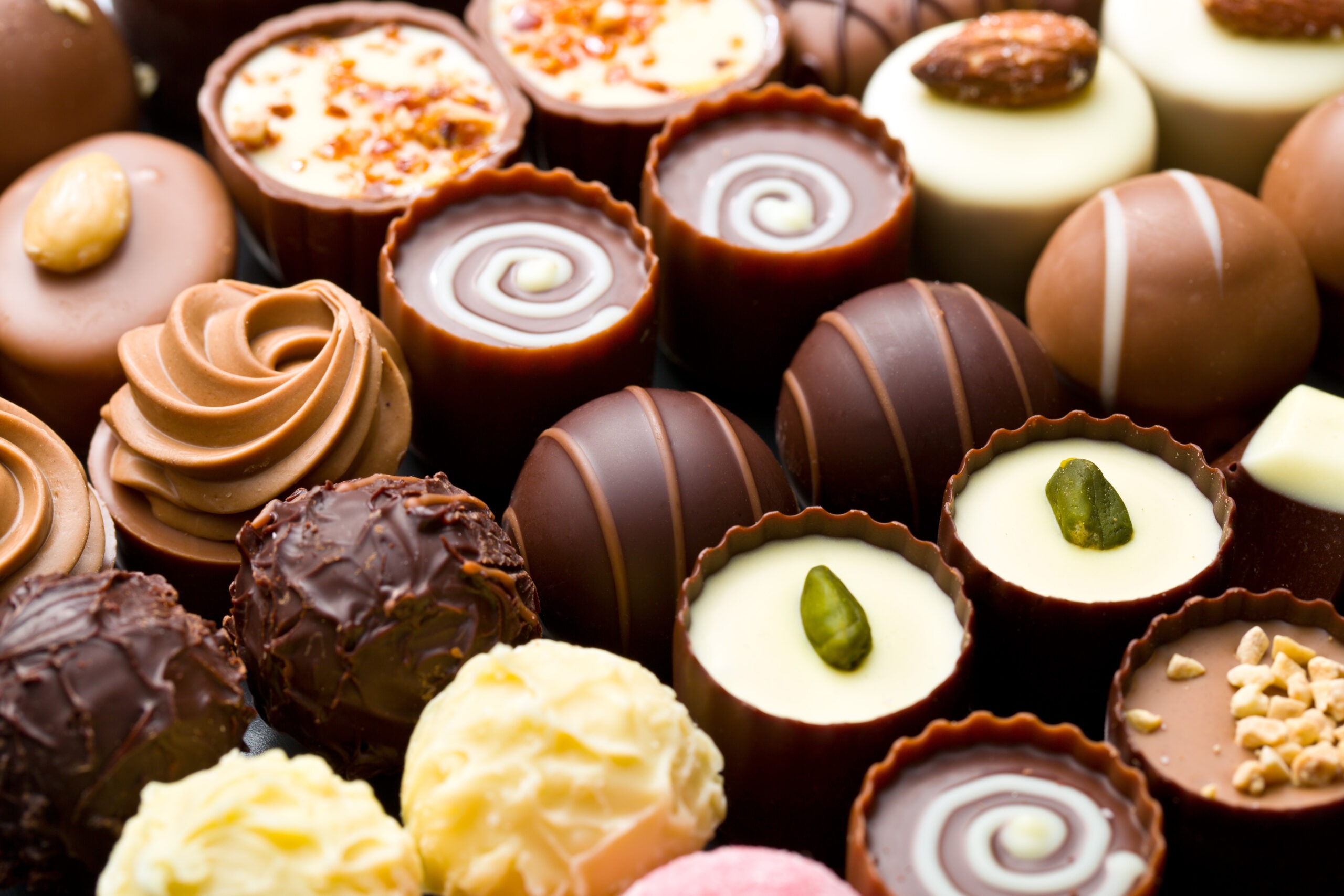How is Chocolate Made | Chocolate Trends and Demand | About Cocoa Butter | Cocoa Butter Alternatives | CBS | CBR | CBE
The Captivating Appeal of Chocolates
There’s something universally enchanting about chocolate. Its rich, velvety texture and complex flavors have captivated our senses for centuries. From the moment it melts in your mouth, it provides a sensory experience of sweet, bitter, and creamy notes. The importance of mouthfeel – how chocolate feels as it melts in your mouth – cannot be overstated, as it significantly enhances the overall appeal of chocolates. Whether savored as a solitary indulgence, shared during celebrations, or gifted as a token of affection, chocolate has woven itself into the fabric of our lives.
But have you ever wondered what goes into making chocolate? Let’s delve into the journey from cacao beans to chocolate bars and explore the role of cocoa butter and its innovative alternatives in crafting the chocolate we adore.
How Is Chocolate Made?
Chocolate originates from cacao beans, which come from the Theobroma cacao tree. Grown in tropical climates, the tree produces fruit in the form of cacao pods, which is the main ingredient in chocolate. From the cacao pods, the journey of chocolate production starts as follows:
1. Harvesting
Cacao pods are carefully harvested by hand to avoid damaging the tree. The pods are opened to extract the beans, which are covered in a sticky pulp.
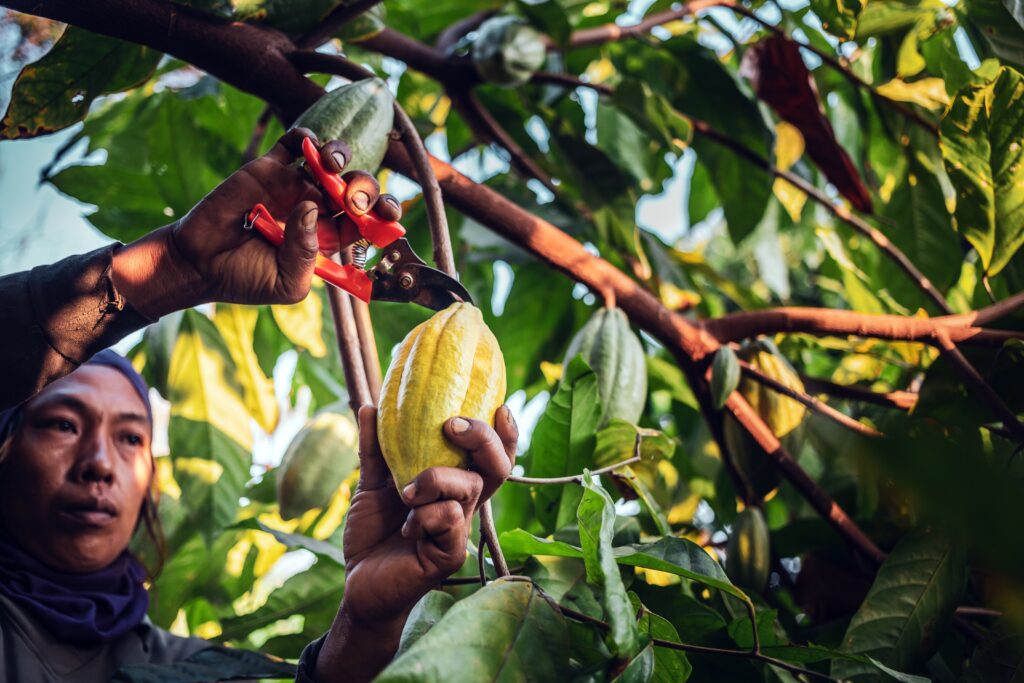
2. Fermenting
The beans and pulp are then placed in large, covered fermentation boxes that keep them exposed to air while keeping the temperature between 40 and 50ºC. Fermentation is essential as it kills harmful bacteria and germs; it takes up to 8 days. During this process, the beans are stirred daily to ensure they have an even amount of oxygen, and this is also the process that helps the beans develop a deeper flavor. Once fermented, the seeds are then referred to as cocoa beans.
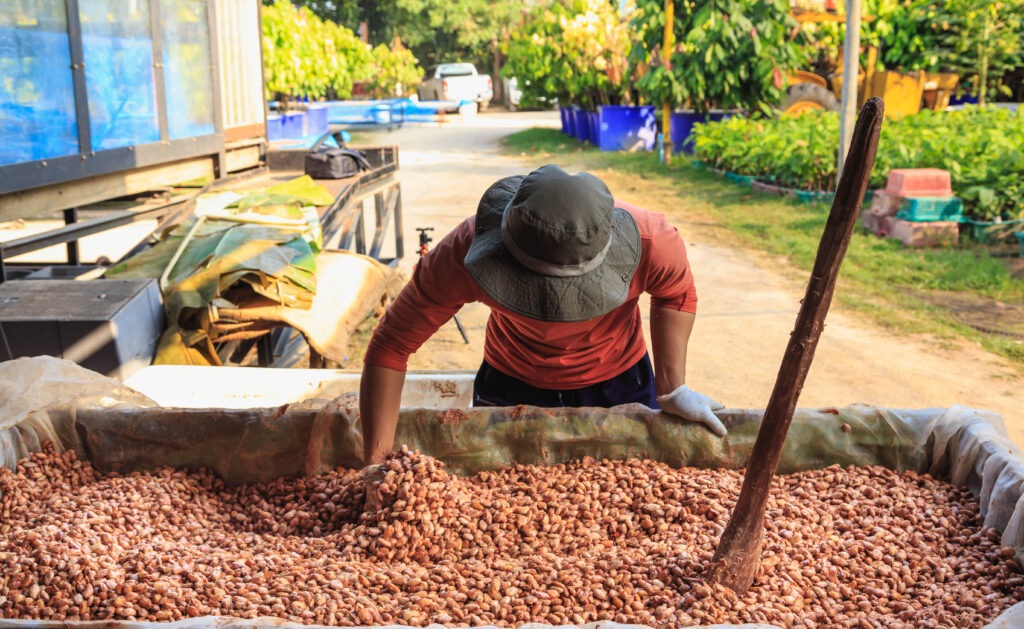
3. Drying
After fermentation, the beans are sun-dried to remove excess moisture. This step is crucial to prevent further fermentation and preserve the flavor.
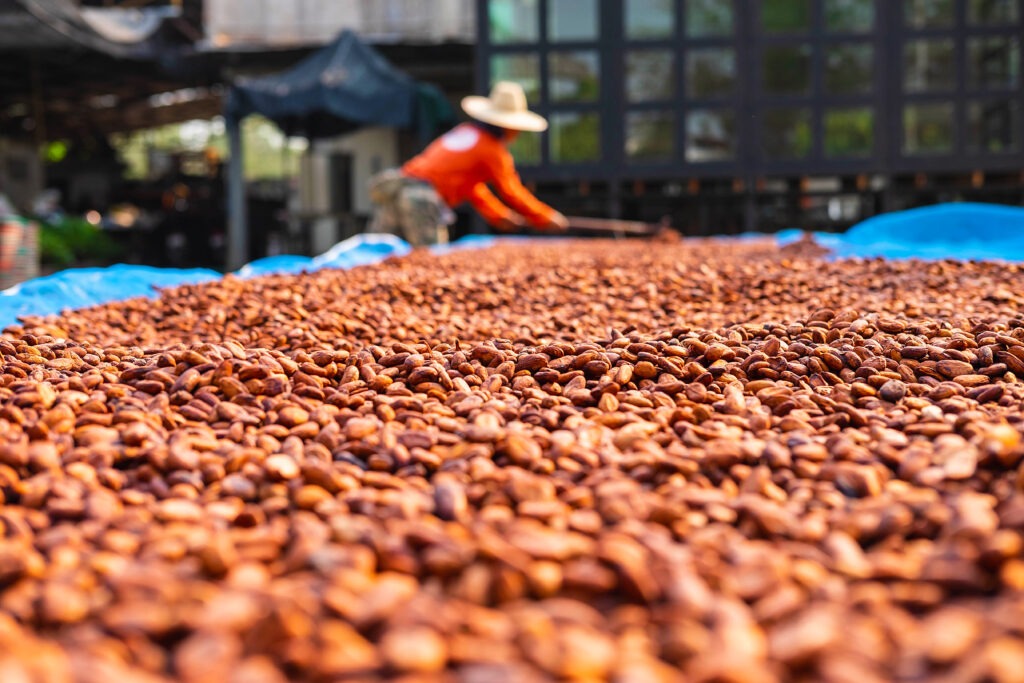
4. Roasting
The beans are sorted and checked for quality at the factory, and moldy beans and debris are sieved out. The dried beans are roasted at varying temperatures depending on their size and type. Roasting enhances the beans’ flavor profile and eliminates any remaining bacteria.
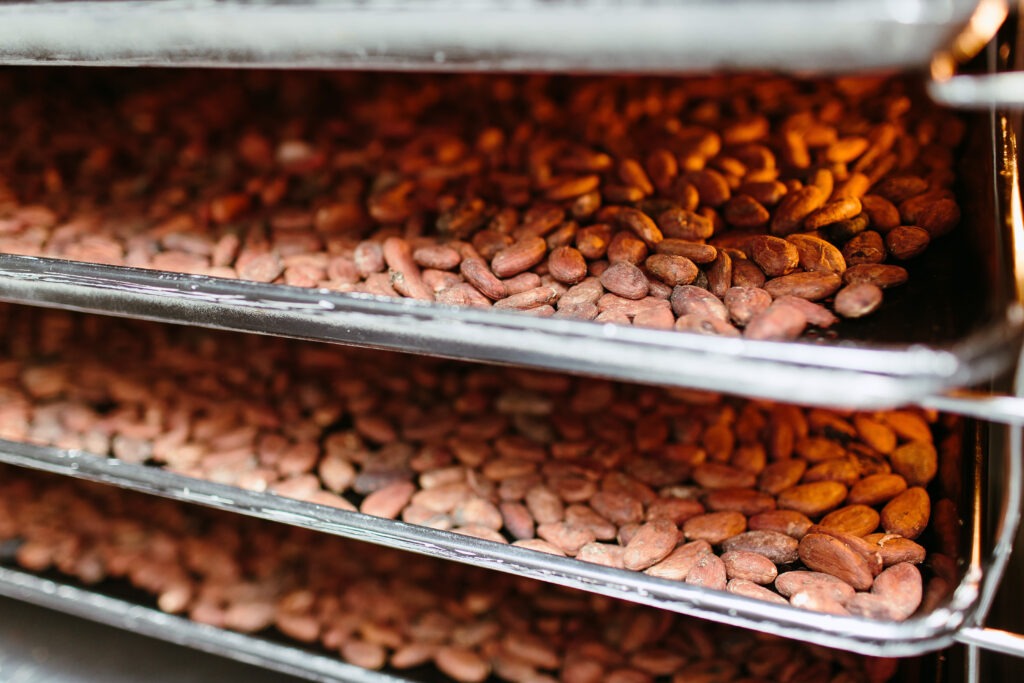
5. Winnowing
Next, the outer shells need to be removed, and this is usually done using a winnowing machine that uses bursts of air to separate the beans into shells and cocoa nibs. The latter is used in the chocolate production process.
6. Grinding and Conching
The nibs are ground into a thick paste known as cocoa mass (cocoa liquor), which can be separated into cocoa solids and cocoa butter. With further grinding, the texture becomes smoother. During this process, additional ingredients such as sugar, milk powder, or vanilla are incorporated. For example, milk chocolate would incorporate more milk powder.
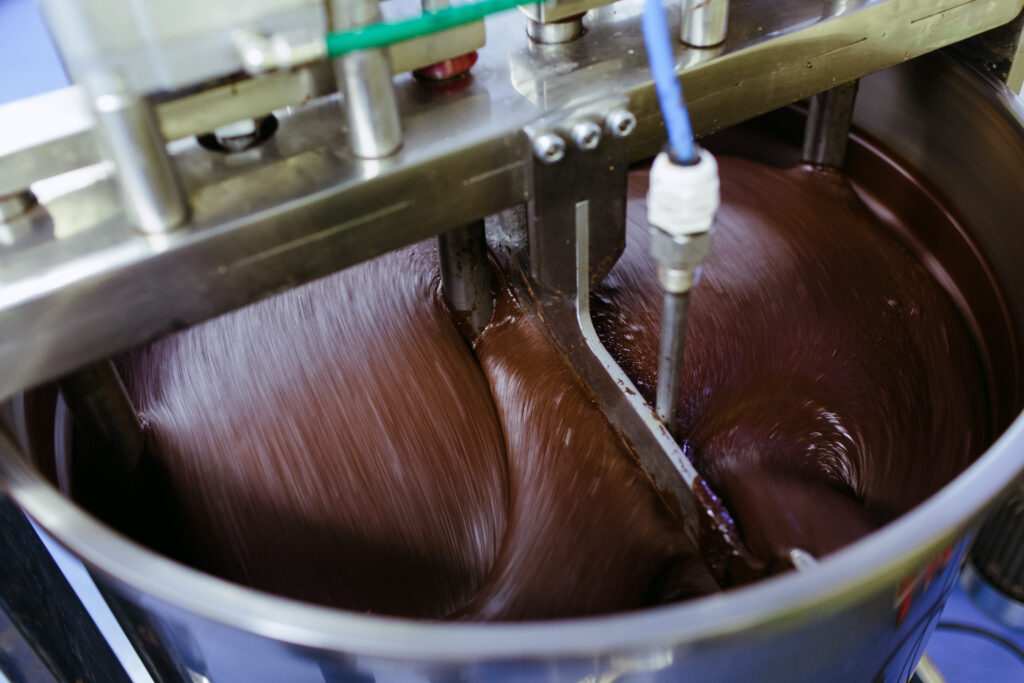
7. Tempering
The chocolate is tempered by carefully heating and cooling it to stabilize the cocoa butter crystals. This ensures a glossy appearance and smooth texture while firm, producing the characteristic snap effect when a piece of chocolate is broken by being bitten or by hand. Without this step, the chocolate would be dull and crumbly. This process can be done manually or using tempering machines.
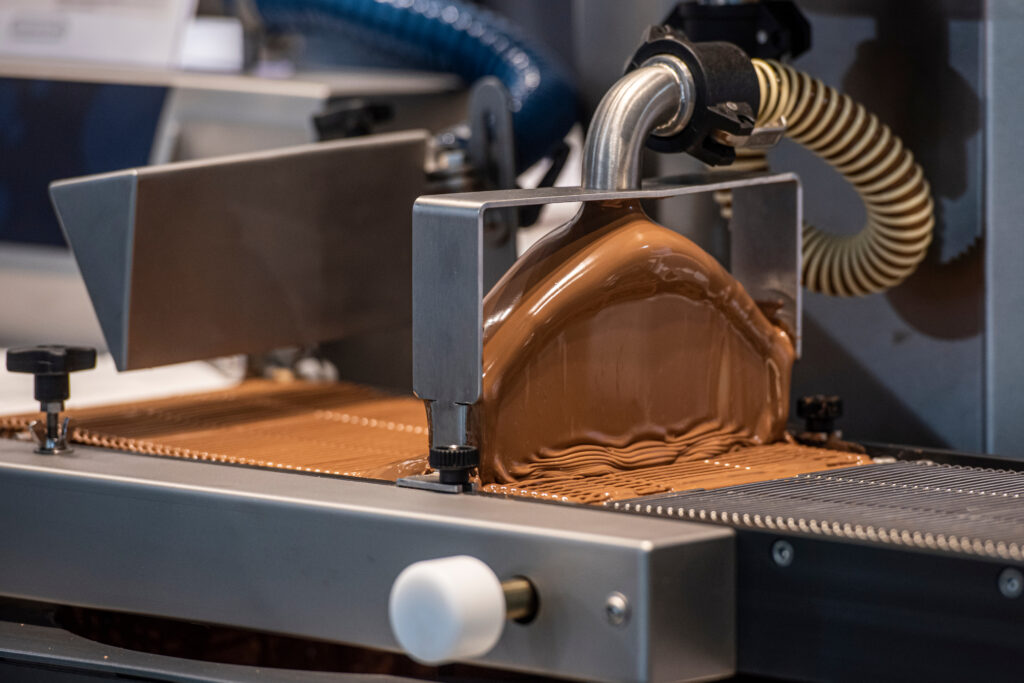
8. Molding and finishing
The tempered chocolate is poured into molds to create bars or other shapes and cooled until solid. It can also be used for different applications.
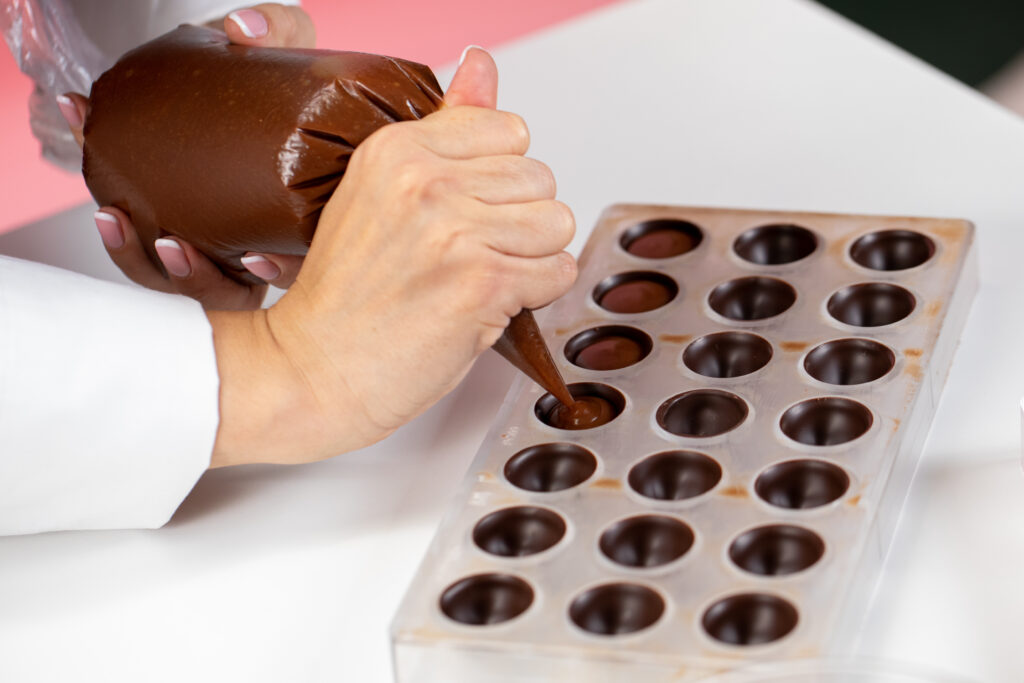
The Trends and Demand for Chocolate
Consumers are demanding a wider array of chocolate products and flavors. There is a growing demand for dark chocolate and reduced-sugar varieties for health reasons, plant-based dairy-free options, innovative flavors incorporating non-traditional ingredients like species, and others. The global market size for chocolate was estimated at US$119.4 billion in 2023 and is expected to grow at a compound annual growth rate (CAGR) of 4.1% from 2024 to 2030.1
The Asia-Pacific region has been seeing a growth in chocolate consumption, driven by rising disposable incomes and an expanding middle class. The growth has also given rise to innovative flavors and products that cater to local tastes, such as matcha-infused chocolates in Japan or durian-flavored chocolates in Southeast Asia.
However, chocolate prices have spiked in recent years. Poor weather conditions, such as droughts and excessive rainfall, have affected yields and output. As a result, cocoa prices have spiked since 2023. From US$2,500 a ton in the 2010s, cocoa has been trading at US6,000 to US$11,000 in April 2024.
Cocoa Butter: The Most Expensive Component of Chocolate
Increasing cocoa prices have placed a spotlight on the most expensive ingredient in chocolate, cocoa butter. Cocoa butter is the fat found in cocoa beans and gives chocolate its decadent and creamy texture. Pale yellow in color, it also has a pleasant flavor and aroma of cocoa and a melting point slightly below human body temperature.
During the processing of cocoa beans, cocoa butter can be extracted during the grinding process explained above. The amount of cocoa butter can be altered to change the texture and melt properties of the chocolate.
Cocoa butter has a low melting point of around 35°C, which is in line with human body temperature and gives chocolate its melt-in-mouth property. However, its low temperature poses handling and logistic challenges in warmer climates, including much of the Asia Pacific region. Cocoa butter’s low melting point also poses challenges when used in specific chocolate applications, such as for coatings to keep their form and remain solid on store shelves.
Alternatives Are There to Cocoa Butter?
The increasing prices of cocoa, including the high cost of cocoa butter and specific application demands, have all led to a demand for alternatives. Here are some key alternatives:
Cocoa Butter Substitute (CBS)
CBS is used to replace cocoa butter entirely in chocolate and confectionery products. Typically made from palm kernel oil, CBS can achieve a similar melting profile to cocoa butter. The primary benefit of CBS is its cost-effectiveness; it is significantly cheaper than cocoa butter, making it a popular choice for mass-market chocolates and coatings. Additionally, CBS has good snap and gloss characteristics, making it suitable for chocolate products that require a firm texture and shiny appearance. However, a key difference with cocoa butter is that CBS doesn’t need a specific tempering procedure and is much easier to handle during production. Despite these benefits, CBS might slightly alter the mouthfeel compared to traditional cocoa butter, often leading to a firmer or more brittle texture.
Musim Mas’ Cocoa Butter Substitute Goldchoc™ and Goldkote® ranges are specially designed for molding, enrobing, and coating applications. They are highly versatile and can be used for a broad range of applications, enabling confectionery manufacturers to innovate.
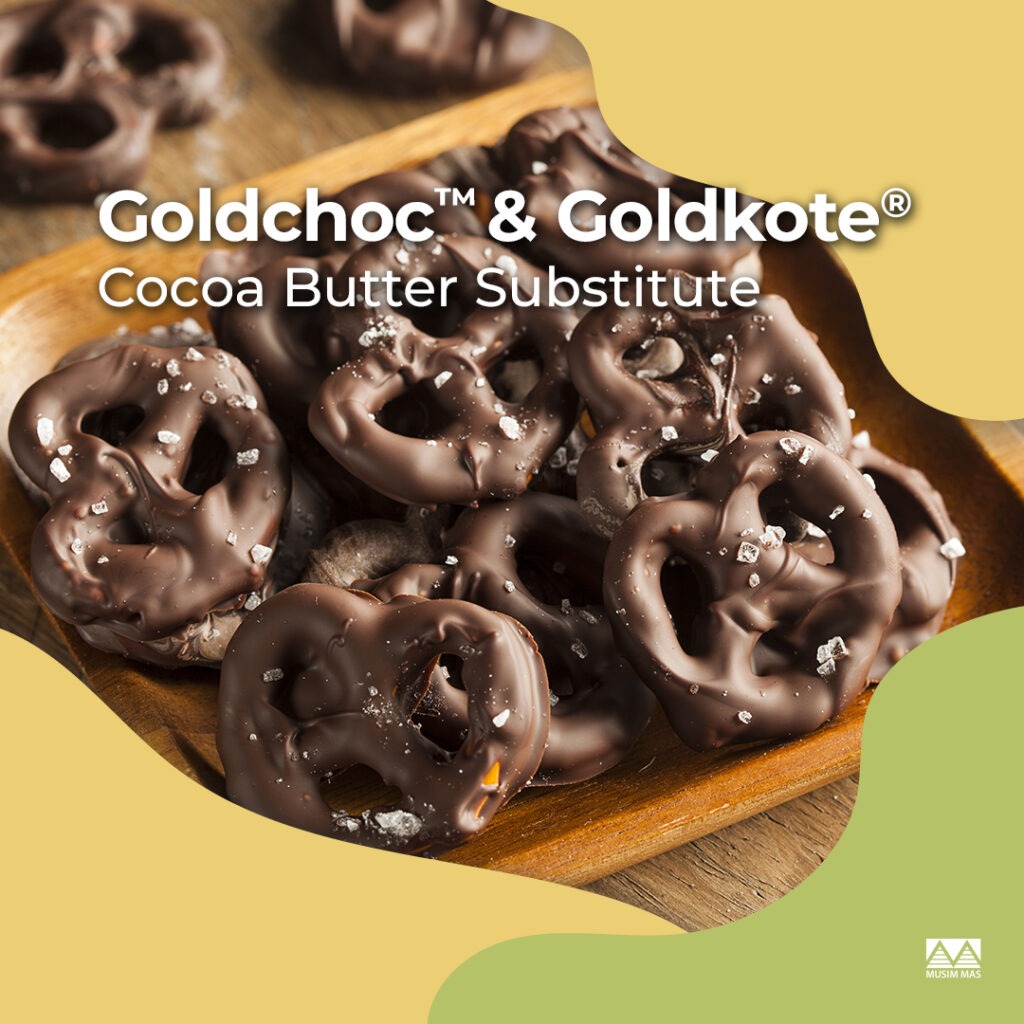
Cocoa Butter Replacer (CBR)
CBRs are designed to replace cocoa butter in chocolate formulations but can tolerate slightly higher amounts of Cocoa Butter. They are often derived from vegetable oils, such as palm olein, soya bean, canola, and sunflower. CBRs can also replace some cocoa butter in a product without significantly altering the chocolate’s sensory properties. The primary benefit of CBRs is their cost savings while maintaining some of the desired characteristics of cocoa butter, such as texture and melting behavior. CBRs differ from CBS because they can be used in higher-quality chocolate products without drastically changing the taste and mouthfeel. CBRs contribute to a similar mouthfeel as cocoa butter, though the experience might be slightly less smooth or creamy, depending on the formulation and the proportion used.
Meeting the need for easy-to-use applications without the need for tempering, Musim Mas’ Cocoa Butter Replacer CBR Choco® range is excellent for molding, coating, panning, and inclusions. It has a cocoa butter tolerance of up to 20%
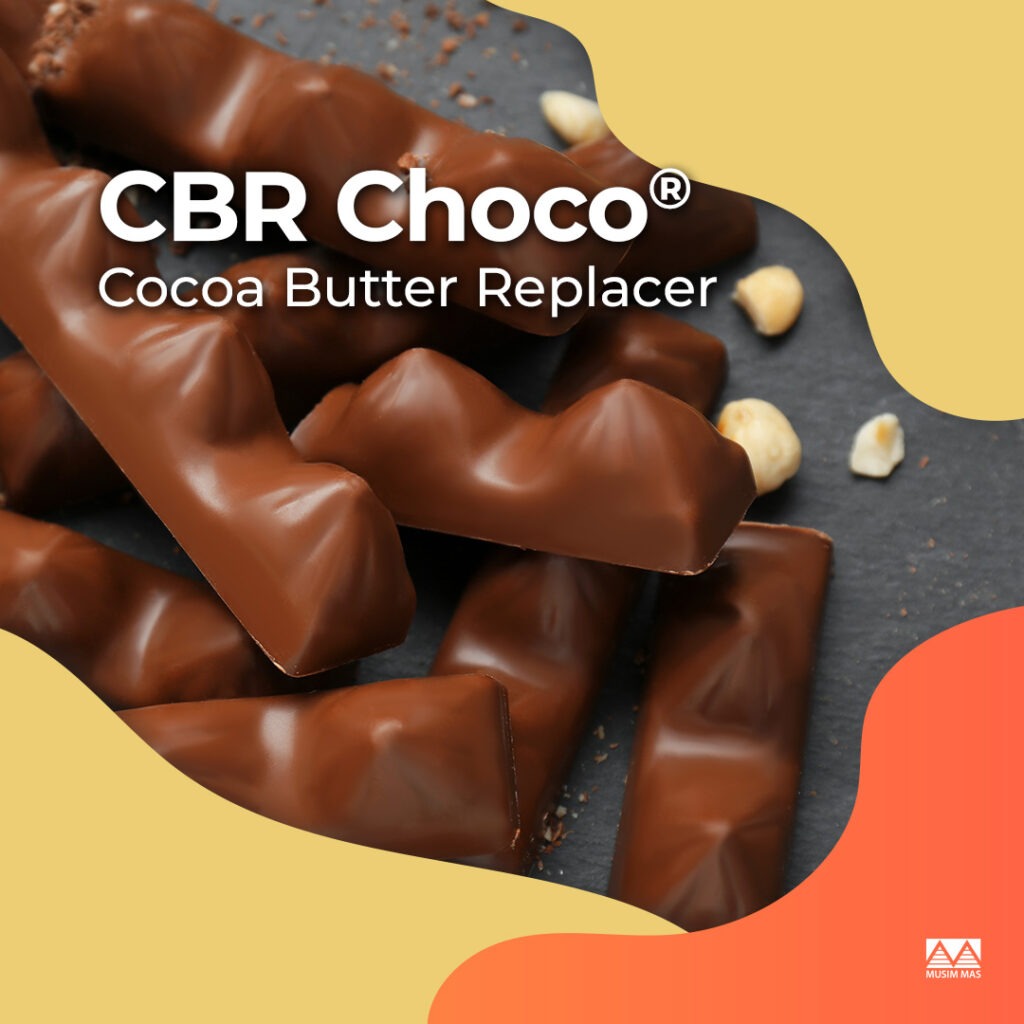
Cocoa Butter Equivalent
Cocoa Butter Equivalent (CBE) can replace cocoa butter in chocolate formulations without compromising quality. They are typically made from a blend of vegetable oils and feature the ideal snap and mouthfeel of chocolates. Unlike CBS and CBR, CBEs can be used up to 100% replacement in some applications. This makes CBEs particularly valuable for high-quality chocolate products where maintaining the traditional characteristics of cocoa butter is essential. CBEs are formulated to closely mimic the mouthfeel of cocoa butter, providing a rich, smooth, and melt-in-the-mouth experience that is nearly indistinguishable from chocolate made with pure cocoa butter.
Fully compatible with cocoa butter, Musim Mas’ Cocoa Butter Equivalent CBE Choco® range is suitable for chocolates and super coatings. It can be tailored for use in different climates to be heat resistant or withstand winter conditions. Like CBR Choco®, it can also be used for molding, coating, panning, and inclusions. Musim Mas’ CBE Choco® NE50 is free of exotic fats, unlike most CBEs, offering additional cost savings without altering taste or sensory properties.
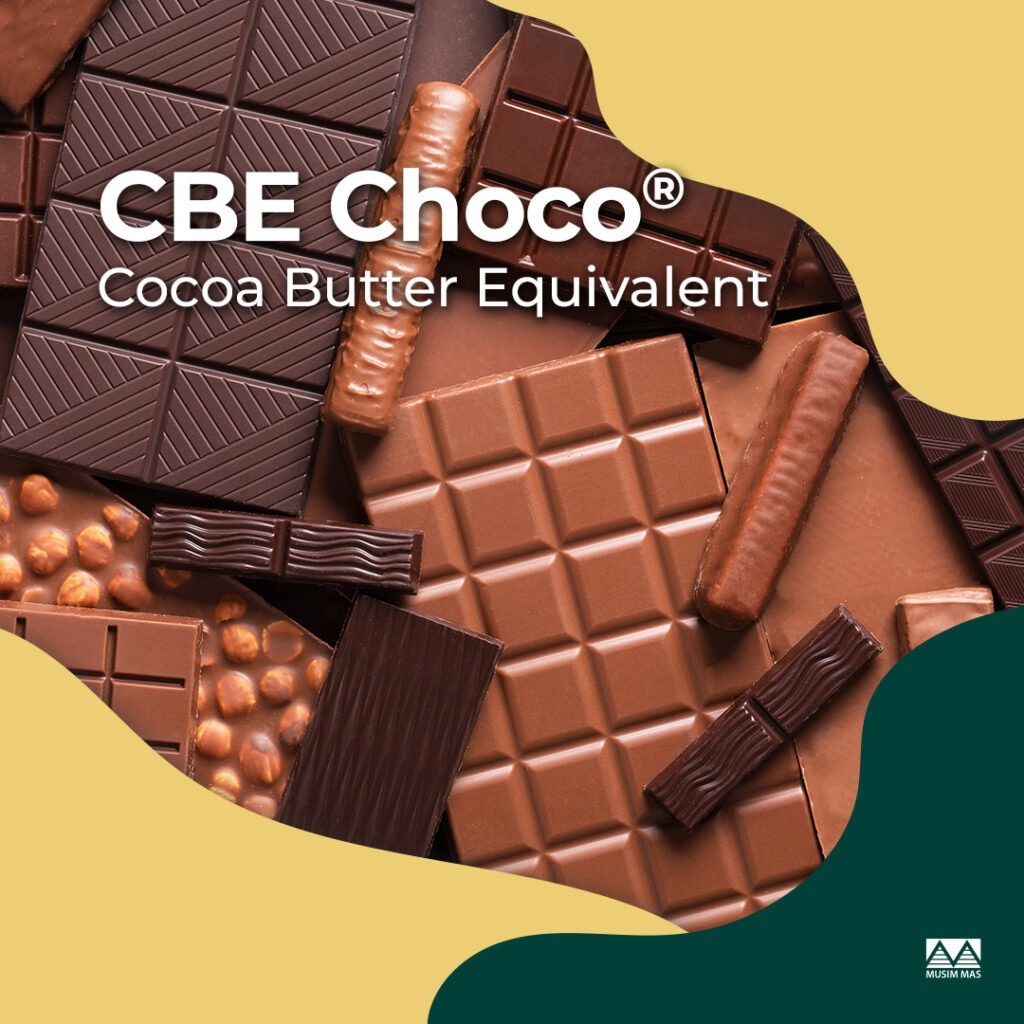
CBS vs CBR vs CBE
| Cocoa Butter Substitute (CBS) | Cocoa Butter Replacer (CBR) | Cocoa Butter Equivalent (CBE) | |
| Sources | Palm kernel oil | Palm olein, soya oil, canola oil, and sunflower oil | Palm oil, shea stearin, illipe butter, kokum butter, mango kernel stearin, and sal stearin |
| Type of Fatty Acids | Lauric | Non-lauric | Non-lauric |
| Formulation | Not compatible with cocoa butter Used to replace it entirely |
Partially compatible with cocoa butter | Fully compatible with cocoa butter Can be mixed with cocoa butter in any given ratio |
| Key Applications | Molding, coatings, enrobing, and panning | Molding, coatings, enrobing, and panning | Molding, coatings, and enrobing |
Regulations on Cocoa Butter in Chocolates
With the growing demand for chocolate products and increasing cocoa prices, cocoa butter alternatives offer a huge potential for confectionery producers to remain competitive. However, it is important to note regulations on their formulation and labeling in specific regions.
In the US, under the Food and Drug Administration’s standard of identity, the sole use of cocoa butter as the fat source is necessary for products to be labeled as chocolate. The use of a cocoa butter alternative will require a different naming convention.2
In Europe, on the other hand, up to 5% replacement of cocoa butter is permitted for a product to be still called chocolate under Directive 2000/36/EC.3 Products that use cocoa butter alternatives must also label that a substitute is used.
In Canada, chocolates must contain at least 35% cocoa solids, of which at least 18% must be cocoa butter.4
Enabling Chocolate Innovations
Cocoa butter alternatives can enable innovations while enabling confectionery producers to remain price competitive, especially with the increase in cocoa prices and consumers demanding innovative new flavors. As a leading specialty fats supplier, Musim Mas produces specialty fats like cocoa butter alternatives for a wide range of applications.
Musim Mas further supports confectionery producers with its innovation and applications center, the Novel IDEAS Center. Dedicated to developing new solutions using the group’s leading specialty fat products and others, the center aims to enable producers to innovate and stay ahead in quality product development and formulation.
_______________________________________________________________________
References:
[1]https://www.grandviewresearch.com/industry-analysis/chocolate-market
[4] https://laws-lois.justice.gc.ca/eng/regulations/c.r.c.,_c._870/page-22.html
[5] https://www.whitakerschocolates.com/blogs/blog/how-is-chocolate-made-step-by-step
[6]https://www.businesstimes.com.sg/companies-markets/why-prices-chocolate-and-cocoa-went-nuts
[7] https://www.ulprospector.com/knowledge/1085/fbn-cocoa-butter-alternatives-chocolate/
[8] https://www.sciencedirect.com/science/article/pii/S1658077X17303387
[9] https://www.sciencedirect.com/science/article/pii/S2772753X23003362
[10] https://www.chocolate-academy.com/en/inspiration/trends/coatings-fillings-and-science-fats







